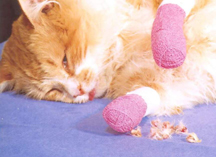Top Reasons NOT to Declaw a Cat

If you are thinking of declawing a cat, or a veterinarian suggests declawing at the same time as neutering, before you make a decision for non-reversible surgery, please consider these reasons NOT to declaw. Your cat will live his remaining years with the result of your decision, one way or another.
1. Declawing is NOT Just Nail Trimming
Nor is declawing only the removal of a portion of a claw. Instead, it is the surgical amputation of the first joint of the cat's toes. Whether this procedure is accomplished with a scalpel, a guillotine-type cutter or a laser, it is major surgery, and not to be undertaken lightly.
2. Declawing Does Nothing to Benefit the Cat
You will sometimes hear the disclaimer, "It's better than putting him to sleep." This is a fallacious argument, and usually offered only to soothe the owner's conscience. Only the cat's owner can make the decision to kill her cat because of scratching problems. He or she can also make the decision to let him keep his toes. Unlike neutering, which does benefit the cat, both health wise and behavioral wise, declawing simply does nothing positive for the cat.
3. Declawing Robs a Cat of His Chief Weapon of Defense
A typical counter-argument is, "My cat is indoors-only." Even indoor cats sometimes manage to escape. A declawed cat does not stand a chance against a large dog, a bigger cat, or a predator. Although he still has teeth, by the time he gets in close enough to bite, it may be too late.
<article class="list content widget expert-content">
<section class="list-unit group">
4. Declawing is Painful Surgery
Think of it as 10 amputations (if only the front feet are declawed). Pain meds may help initially, but phantom pain may last for weeks or months, as nerve endings heal. Dr. Nicholas Dodman describes the pain following surgery: "Unlike routine recoveries, including recovery from neutering surgeries, which are fairly peaceful, declawing surgery results in cats bouncing off the walls of the recovery cage because of excruciating pain."
</section>
<section class="list-unit group">
5. Declawing May Lead to Litter Box Problems
Declawed cats often associate the pain when digging in litter with the litter box itself, and will avoid it, choosing softer carpeting instead.
</section>
<section class="list-unit group">
6. Declawing Sometimes Leads to Biting Problems
When cats lose their ability to give a quick warning scratch, they will often resort to their second line of defense: a good, hard bite. The cat's owner may sometimes find himself the victim, just when he thinks his cat is enjoying a petting session.
</section>
<section class="list-unit group">
7. Cats Need the Exercise Their Claws and Toes Provide
Watch a cat stretch, whether horizontally on a carpet or vertically with a tall scratching post. He will grab the carpet or sisal with his claws, using the resistance to pull and stretch his muscles. Cats' claws actually play a large and positive role in their amazing muscle tone and agility.
</section>
<section class="list-unit group">
8. Altered Gait May Lead to Later Joint Problems
Domestic cats are digitigrade, meaning they walk on their toes. Walking with an altered gait because of the lack of the first digit of the toes can affect all the joints of the leg, resulting later in arthritis of the hip and other joints. Jean Hofve, DVM describes this joint deterioration more fully, in her article, "A Rational Look at Declawing."
</section>
<section class="list-unit group">
9. Cats Need to Be Cats for Their Entire "Nine Lives"
Honestly, if a cat could speak human language, do you really think, given a choice, he'd say, "Sure thing. Cut off part of my toes?" His claws and toes are an integral part of making a cat a cat. Would you honestly want him to be anything less, especially since there are humane alternatives? It's your decision, but please take your cat's needs into serious consideration before making such a drastic and permanent choice.
</section>
</article>


 bootsie1
bootsie1
 country bumpkin
country bumpkin




